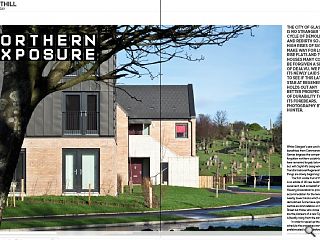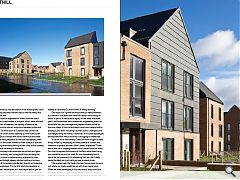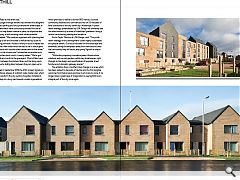Sighthill: Northern Exposure
12 Jul 2016
The city of Glasgow is no stranger to the cycle of demolition and rebirth so as the high rises of Sighthill make way for low rise flats and town houses many could be forgiven a sense of deja vu. We pound its newly laid streets to see if this latest stab at regeneration holds out any better prospect of durability than its forebears. Photography by Keith Hunter
Whilst Glasgow’s east end has benefitted from Commonwealth Games largesse the comparatively forgotten northern outskirts of the city have remained largely below the radar but with Sighthill’s designation as a Transformational Regeneration Area things are slowly beginning to change.The first visible fruit of this change is an estate of 141 new build houses for social rent, built on behalf of Glasgow Housing Association to provide spill accommodation for the tenants of five nearby tower blocks which are being demolished. Some have opted for more central accommodation on the High Street but those who chose to remain are the pioneers of a new Sighthill which is literally rising from the ashes of the old.
In order to speed up the delivery schedule the properties were all prefabricated by CCG before being winched into place. In this way the tight deadlines imposed by the demolition of the existing flats could be met ensuring decanted tenants had a new flat ready and waiting to move into.
This latest stab at regeneration differs from the failed point blocks and maisonettes of the past, which were afflicted by a combination of isolation, low quality infrastructure, fragmentation and a blurred distinction between public and private space. To avoid such ills Collective has carved out three distinctive urban blocks opening up new north/south connections. Each of these new blocks reinforces the street edge and in so doing responds to the local topography, with flatted blocks to the south limited to three storeys to prevent overshadowing of terracing linking to flats of up to four storeys which overlook a cemetery to the north.
Feature doorways with extensive use of brick and glass help provide continuity and strong built forms evoking the Baronial style provide a contemporary response to crow stepped gables through steeply pitched roofs and corners.
On a tour of the estate Jude Barber, director at Collective Architecture, explained: “It’s the first site to be develops as part of the wider master plan, so it was important to give it a sense of identity. We wanted the streets to have character and retain unity across the whole site. Because we’re up on a hill we looked at traditional Scottish forms of hilltop dwelling.”
One aspect of Sighthill life the architects were powerless to confront is the distinctive smell of sulphur which hangs in the air in parts. A malodorous legacy of the areas industrial past it will necessitate some mammoth engineering works to remediate land, lay drainage and prepare infrastructure for the next phase. In this the architects must also contend with a patchy public realm including a sunken public underpass and submerged lamp standards, a reminder of the post-apocalyptic atmosphere from which the area is struggling to shake free.
To carve out a new identity Collective have sought to keep things simple by employing a limited palette of colours and materials as project architect Mairi Laverty explained: “There was a little bit of capping needed which helped with the levels. Zinc was to express the corners of the flats rather than being too monolithic across the road. If it was completely brick it would be too dominant, it’s interesting that you don’t really sense the black so much until you see an aerial photo.
“We worked with the Youth Olympic Games team to work out where our roads would line up with their master plan. When we were developing it this road would loop round the cemetery and meet up at Cowlair via an improved bridge over the motorway. At the moment you have to come round Keppochhill Road to the other side.”
Low car usage amongst tenants has allowed the designers to apply limited parking and thus promote the streetscape; in addition the architects have consciously avoided the use of blank gables to help foster a sense of place, an objective also achieved by tying in with existing roads where possible.
Laverty added: “We made an argument with planning that car ownership is low and the area is well served by buses to reduce parking provision. Access is tricky on such a sloped site and there were a few roads which we had to tie in which gave us parcels of land with double sided connections to the street.”
Included in the scheme are 11 wheelchair accessible units and shared surface back courts. Laverty added: “We’ve got the view south and north to the graveyard. Most of flats have through light between the kitchen/diner and the living room. Because it’s just a sliding door between they can open up to both sides.”
Completed in September 2015 the £13m project signals an intention for future phases of a district-wide master plan which promises to transform the city centre’s forgotten hinterland. It is the first step on a long road toward a wider regeneration which promises to deliver a further 800 homes, a school, community facilities and commercial units on 50 hectares of land connected to the city centre by a footbridge. A public realm strategy spearheaded by LDA Design will ultimately see this area bisected by a series of interlinked ‘parkettes’ along a central route hosting seating and sculpture.
Kirstin Taylor, Director at LDA Design, said: “The public realm strategy in this development is both highly sustainable and people centric. Our focus has been on the landscape and amenities, taking the emphasis away from vehicles and onto the community they will serve, and giving Sighthill a unique identity.
“We’re also proposing innovative green infrastructure solutions such as rain gardens within key streetscapes, right through to the design and specification of bespoke street furniture and dramatic gateway spaces.”
The ambition then is to effect step change in an area which has been subject to decades of decline and the first tangible outcome from that process promise much more to come. It no longer takes a great leap of imagination to see Sighthill as an integral part of the city once again.
|
|
Read next: St James Centre: Shop Till it Drops
Read previous: Wood for Good: Lumbering Up
Back to July 2016
Browse Features Archive
Search
News
For more news from the industry visit our News section.
Features & Reports
For more information from the industry visit our Features & Reports section.





